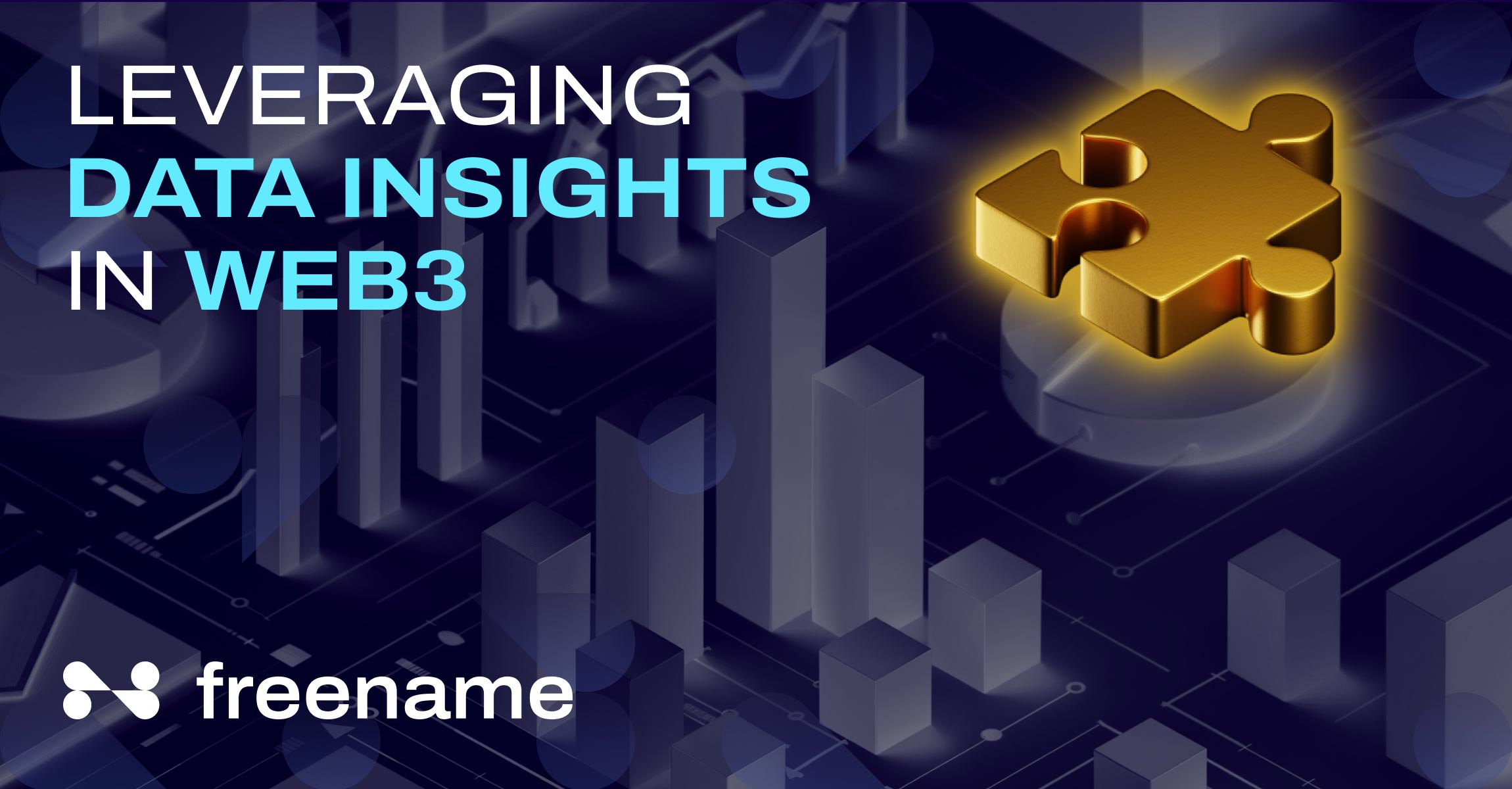Imagine a web where you ditch the forgettable usernames and passwords, and instead claim a unique digital address that reflects your brand or identity. That’s the power of Web3 domains, and here, we’re not just users but active participants, owning and controlling our digital identities.
But here’s the twist: unlike those old domain names, Web3 domains are built on blockchain technology, and they come with a wealth of untapped data. This is where Web3 domain analytics comes in. It isn’t just about numbers and charts; it’s about understanding the heartbeat of your digital presence. It’s about knowing who’s knocking on your digital door, what paths they’re taking, and how you can make their journey better.
In this article, we’ll walk you through the tools and techniques you need to make sense of your Web3 domain data. We’ll also show you how to turn raw data into valuable insights that can guide your decisions and strategies.
Understanding Web3 Domains and the Need for New Analytics
What makes Web3 domains unique? Let us unpack that before we unpack the analytics toolbox.
Web3 domains are a new breed of human-readable addresses built on blockchain technology, the same system that powers cryptocurrencies. They’re like your home address but on the internet and they help others find your digital property. Just this time, instead of renting them, you own them completely, unlike with regular domains. Since you own the domain and not some central authority, this gives you greater control and security.
So, why are traditional website analytics a bit rusty when it comes to Web3 domains? Traditional web analytics are like detectives, following users’ footprints across the web. They track clicks, page views, bounce rates, and so much more. But when it comes to Web3 domains, they hit a wall.
Why?
Because the decentralized web is a different beast. On the blockchain, user interactions are transactions. But these transactions are more than just numbers; they’re rich with data.
The problem is that traditional analytics rely on data stored on centralized servers, which doesn’t capture the full picture in the decentralized world. Plus, they often miss out on the valuable on-chain data – the information stored directly on the blockchain that provides more indepth insights about a Web3 domain.
Think of it like trying to navigate a new city with an outdated map. You might get there eventually, but you’ll miss all the hidden gems along the way. That’s why we need new analytics specifically designed for Web3 domains. These tools can dive into the blockchain, catch the data we need, and help us understand our digital property better.
Examples of Web3 Data Insights That Can Be Gained From Analytics
Web3 domain analytics goes beyond just website traffic. It opens up a wealth of data regarding the online activities surrounding your domain and the larger Web3 environment. Here are some gold nuggets you can unearth:
- Domain Popularity: Analytics can track registration trends, revealing how popular specific domain extensions are (.eth, .bnb, etc.) and identifying rising stars in the Web3 space.
- Community Engagement: Analytics can reveal how actively users are interacting with your domain on social media or within specific Web3 communities.
- Wallet Activity: See who’s behind the curtain! Analytics can help identify the types of wallets interacting with your domain, giving you clues about your audience’s demographics and interests.
- Brand Awareness: Measure the impact of your marketing efforts. Analytics can track mentions of your domain across the decentralized web, showing how effectively you’re spreading the word.
- Domain-Specific User Engagement: Track domain interactions like internal link clicks, subpage visits, and DeFi application integration. This granular data helps you optimize content and features for your audience.
- Identifying Valuable Collaborations: The beauty of Web3 is its interconnectedness. Web3 analytics can identify demographically related communities and projects. This allows partnerships and Web3 ecosystem growth.
- Emerging Trends: You can stay ahead of the curve, as analytics can help you identify new applications for Web3 domains and spot trends that could impact your strategy.
- Privacy-Preserving Insights: Privacy is one of Web3 domain analytics’ main benefits. Web3 analytics provides insights using anonymized data, which matches decentralized web values as opposed to tracking people without consent.
Key Metrics in Web3 Analytics
In Web3 analytics, several key metrics can provide valuable insights into the performance and usage of decentralized platforms.
Wallet activity and user interactions are crucial for understanding how users engage with your site or dApp, including the frequency and types of transactions they perform.
Token transactions and financial flows help track the movement of assets within the ecosystem, revealing patterns in trading, spending, and investment.
Monitoring usage patterns of decentralized applications (dApps) offers insights into user preferences, popular features, and areas needing improvement.
Additionally, network health and performance indicators are essential for assessing the overall stability, efficiency, and scalability of the underlying blockchain infrastructure, ensuring a seamless user experience.
Top Tools for Web3 Domain Analytics
With the correct resources, you can discover all of your Web3 domain’s hidden secrets. The following are some of the most popular choices when it comes to analytics and data analysis for Web3 domains.
On-Chain Data Analysis Platforms
When it comes to Web3 analytics, a variety of decentralized tools and platforms are available to help gather, analyze, and interpret data starting from your own Web3 domain. Here’s an overview of some popular options, along with a comparison of their features and capabilities, and a few case studies or examples of these tools in action.
- Dune Analytics: An open-source platform that allows users to create and share custom queries on blockchain data. It provides a collaborative environment where users can build dashboards and share insights with the community.
- Glassnode: Specializes in on-chain data and market intelligence for digital assets. It offers comprehensive insights into blockchain networks, providing metrics and analytics on wallet activity, transactions, and more.
- Nansen: A blockchain analytics platform that combines on-chain data with a massive database of wallet labels. It offers deep insights into wallet behavior, token movements, and the activities of prominent entities within the ecosystem.
- The Graph: A decentralized indexing protocol for querying blockchain data. It allows developers to build and publish open APIs (subgraphs) that can be queried for data, making it easier to access and analyze blockchain information.
Comparison of Features and Capabilities
| Tool | Features | Capabilities |
|---|---|---|
| Dune Analytics | Custom queries, community dashboards, open-source | Collaborative data analysis, flexible queries |
| Glassnode | On-chain metrics, market insights, advanced charts | Comprehensive blockchain data, real-time analysis |
| Nansen | Wallet labeling, token tracking, entity insights | Detailed wallet behavior, token flow analysis |
| The Graph | Decentralized indexing, API creation, data querying | Efficient data retrieval, supports multiple blockchains |
Web3 Domain Registrar Analytics Dashboards
Some domain registrars, for example us at Freename offer built-in dashboards specifically designed for your kind of domain. These dashboards also provide analysis that is tailored to your Web3 presence, making them a convenient one-stop shop for domain analytics.
Customizing Web3 Analytics for Advanced Users
For those who like to tinker, customizing your analytics can unlock even more insights. You can set up your own metrics, create custom reports, and even integrate your analytics with other tools for a more comprehensive view of your Web3 domain. This, however, requires coding expertise and a deeper understanding of blockchain data.
Other Useful Web3 Analytics Tools
While not strictly domain-specific, tools like Messari offer valuable insights into the broader Web3 ecosystem. They can be helpful for understanding user demographics and trends that might impact your domain.
Other popular crypto analytics tools in the Web3 space include DEX Screener, DefiLlama, Coinalyze, Moralis Money, LunarCrush, and DEXTools. These tools provide real-time data, tracking price movements, trading volumes, and market sentiment. The Graph is another noteworthy tool that enables decentralized data indexing. It’s like a librarian for your blockchain domain data, as it helps you organize and retrieve information efficiently.
Another one, Safary, is a community-driven tool that’s reconstructing the marketing stack in Web3. It helps in deciphering marketing customer acquisition costs (CAC), channel return on investment (ROI), and customer lifetime value (LTV).
Again, note that most of these are valuable for general Web3 analytics but not specifically tailored to Web3 domain analysis.
How To Choose Your Data Analysis Tool For Web3 Domains
When choosing a tool, consider its features, ease of use, and the specific needs of your Web3 domain. Some tools might be better suited for real-time tracking, while others might excel in data visualization. It’s all about finding the right tool for your data mining expedition.
Here are some basic considerations:
Beginners
Start with user-friendly dashboards offered by domain registrars.
Intermediate Users
Explore on-chain data analysis platforms like Dune Analytics.
Advanced Users
Consider customizing your own analytics for maximum flexibility.
Remember that the best tool is the one that lets you find the Web3 domain’s hidden gems.
Implementing Web3 Analytics
Implementing analytics in Web3 domains involves a different approach compared to traditional Web2 analytics. Here are the key steps to integrate analytics into Web3 domains, the role of smart contracts in data collection and analysis, and how to use decentralized storage solutions for analytics data.
Steps to Integrate Analytics into Web3 Domains
- Select an Analytics Platform: Choose a decentralized analytics tool or platform that suits your needs.
- Set Up Data Queries and Dashboards: Configure queries to collect data relevant to your domain. Use the chosen platform’s interface to create dashboards that visualize this data.
- Integrate Smart Contracts: Deploy smart contracts that can log and emit events for significant actions within your dApp or website. These events can include user interactions, transactions, and other relevant activities.
- Collect and Analyze Data: Use the analytics platform to collect the data emitted by your smart contracts. Analyze this data to gain insights into user behavior, transaction patterns, and system performance.
- Regular Monitoring and Adjustment: Continuously monitor the analytics data to identify trends and anomalies. Adjust your queries and smart contracts as needed to refine the data collection process and improve accuracy.
Role of Smart Contracts in Data Collection and Analysis
Smart contracts play a crucial role in the Web3 analytics ecosystem by enabling transparent and tamper-proof data collection. Here’s how they contribute:
- Event Logging: Smart contracts can be programmed to emit events for specific actions, such as user logins, transactions, or changes in state. These events are recorded on the blockchain, providing a reliable data source.
- Automated Data Capture: Since smart contracts execute automatically based on predefined conditions, they ensure consistent and accurate data capture without human intervention.
- Transparency and Security: Data collected via smart contracts is secure and transparent, as it is stored on the blockchain. This ensures that the data is tamper-proof and can be independently verified by any party.
Using Decentralized Storage Solutions for Analytics Data
Storing analytics data on decentralized storage solutions offers several benefits, including enhanced security, privacy, and resistance to censorship. Here’s how to use these solutions:
- Choose a Decentralized Storage Provider: Select a provider such as IPFS (InterPlanetary File System), Arweave, or Filecoin.
- Store Raw Data: Store raw analytics data collected from smart contracts on the chosen decentralized storage platform. This ensures that the data remains immutable and accessible.
- Index and Query Data: Use indexing protocols like The Graph to create subgraphs that facilitate efficient querying of the stored data. This allows you to retrieve specific datasets quickly and easily.
- Maintain Data Privacy: Implement encryption and access control mechanisms to protect sensitive analytics data stored on decentralized platforms. This ensures that only authorized parties can access and analyze the data.
How To Analyse Web3 Domains Data
Now that we’ve got our tools, let’s talk about the techniques. These are the methods we can use to make sense of the data we’ve collected:
Analyzing Domain Registration Trends
Just like any market, Web3 domains have trends. By analyzing registration data (e.g., popularity of or demand for specific extensions like .eth or .nft), you can identify emerging sectors or spot potential investment opportunities.
Recognizing Wallet Activity Associated with Domains
Next, you can look at wallet activity associated with domains. Web3 domains connect to crypto wallets. Analyzing wallet activity (without compromising user privacy) can reveal things like the types of wallets interacting with your domain (think business wallets vs. individual collectors) and their potential interests. For example, you might find that a particular wallet is very active on your domain, which indicates a power user.
Gauging Community Engagement Around Specific Domains
Is your domain generating buzz? Web3 analytics can track social media mentions, comments, likes, shares, forum discussions, or even NFT trading activity related to your domain.
High engagement can be a sign of a vibrant and active community, which is a good indicator of a successful Web3 domain.
Beyond the Basics
There are many other techniques you can use to interpret data from Web3 domains. For example, you might want to look at transaction volumes to gauge the level of activity on your domain. Or you might want to analyze transaction times to understand when your users are most active. But with advanced techniques, you’ll combine data from various sources to paint a richer picture.
Imagine you own a music domain on Web3. Analytics reveal a high number of music NFT collectors interacting with your domain. You can then use this data to identify similar communities or projects with overlapping audiences, opening doors for potential collaborations with music NFT artists.
By using a combination of techniques and a dash of creativity, you can unlock even deeper insights from your Web3 domain data. Remember, the key is to ask the right questions and explore the connections within the data to make informed decisions and propel your Web3 presence forward.
Note that these are just examples. The specific techniques you use will depend on your goals and the nature of your Web3 domain.
But whatever techniques you choose, remember that the goal is to turn data into insights that can guide your decisions and strategies.
Leveraging Analytics for Strategic Domination in Web3
The power of Web3 domain analytics isn’t just about collecting cool data. It’s about using those insights to make strategic decisions that propel your Web3 project forward. Here’s how:
Data-Driven Marketing Magic
Imagine crafting marketing campaigns tailored to the exact demographics interacting with your domain. Web3 analytics can reveal user interests and preferences, and help you target your marketing efforts with laser focus. This translates to increased engagement and a higher return on investment (ROI).
Identifying Valuable Trends
The Web3 world is constantly changing. Analytics of domain registration trends and user behavior will help you spot emerging opportunities before they become mainstream. This allows you to adapt your strategy and stay ahead of the curve.
Making Informed Decisions
Web3 analytics empowers you to make data-driven choices about your domain’s development. User data can reveal what content resonates best, informing your content creation strategy. Similarly, analytics can highlight which features on your domain are most popular, which will guide future development decisions.
Application
Let’s say you run a Web3 domain focused on educational resources for DeFi newbies. Analytics reveal a surge in wallet activity from users with limited DeFi experience. This tells you there’s a strong demand for beginner-friendly content. You can then use this insight to:
- Develop a series of explainer videos breaking down complex DeFi concepts into easy-to-understand steps.
- Host live Q&A sessions addressing common questions raised by new DeFi users interacting with your domain.
- Partner with DeFi influencers who cater to a beginner audience, further expanding your reach and attracting new users.
By strategically using the insights gleaned from Web3 domain analytics, you can transform your domain into a thriving hub for DeFi education, attract a loyal community, and establish yourself as a leader in the space.
Remember, Web3 domain analytics is a powerful tool waiting to be wielded. By leveraging its capabilities, you can make informed decisions, identify valuable trends, and propel your Web3 project towards success.
The Future Of Data Analysis For Web3 Domains Is Bright
Data and analytics help us make smart decisions and develop effective strategies in Web3 domains. It is not enough to just gather data; we also need to understand it and use it to our advantage. Currently, we are just scratching the surface. As the Web3 space evolves, so will the analytics tools and techniques. We can expect more advanced analytics platforms, more sophisticated data interpretation methods, and innovative ways to leverage analytics for strategic decisions.
Analytics for Web3 domains is crucial for gaining insights into user behavior, financial transactions, and network health. By implementing robust analytics, developers and businesses can drive adoption, improve user experiences, and make data-driven decisions that align with the decentralized nature of Web3.
In summary, as the Web3 ecosystem continues to grow, embracing comprehensive analytics will be essential. This will not only enhance our understanding of the decentralized web but also unlock new opportunities for innovation and growth. By staying ahead of the curve and continually adapting to emerging trends and technologies, we can fully harness the power of Web3 analytics to shape the future of digital interactions.







